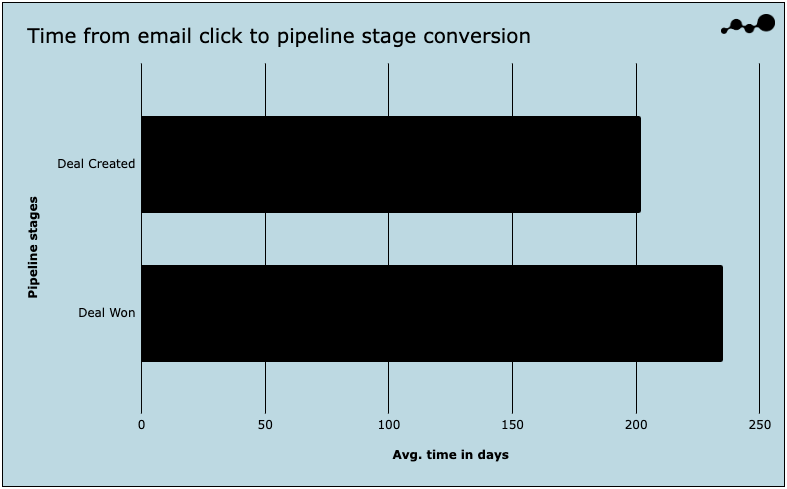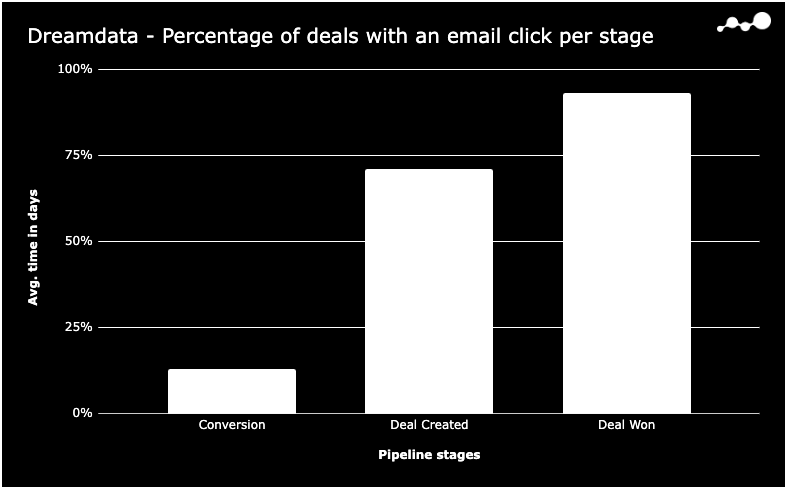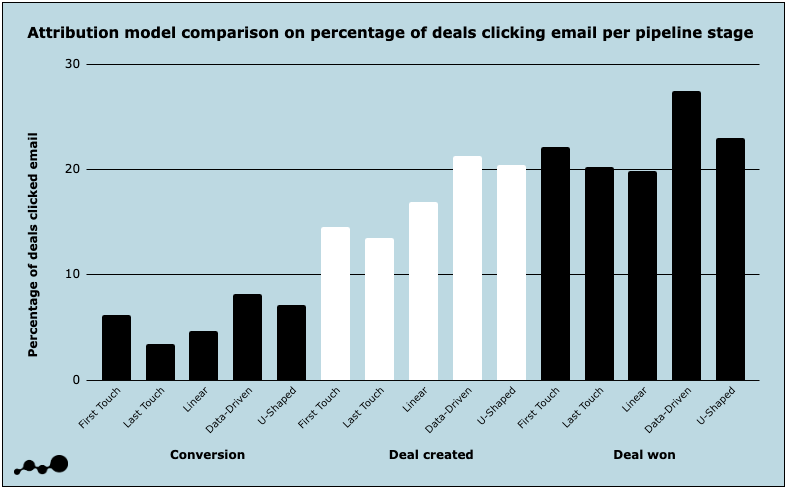B2B Email Benchmarks 2024
This article was originally published March 2023 and updated with new data March 2024
Did you know that +40% of opportunities in the final stage of your pipeline click through on at least 1 tracked email?
Intro to B2B email marketing benchmarks
Email Marketing continues to be an important tool in the B2B marketer’s kit. And there’s no shortage of quality benchmarks out there showing open rates and click-through rates to aid marketers in evaluating performance.
But there’s nothing out there exposing the down-funnel impact of email marketing. Which, for the B2B marketer matters. A lot.
Where in the pipeline are leads/prospects/deals most likely to engage with your marketing emails? How many times does the average deal engage with marketing emails? Do marketing emails speed up the sales process? Does company size influence click rates?
Well, we’ve found some answers in our data, and in this post, we’re exposing post-click/ down-funnel benchmarks on B2B marketing emails.
Contents:
Do emails speed up the customer journey?
How many deals click on emails across the pipeline?
How many email clicks are there on average by pipeline stage?
What percentage of email marketing clicks take place at different pipeline stages (using different attribution models)?
Best practice for B2B email tracking checklist ✅
A word about the data
The data used to put together these benchmarks is anonymised aggregated data* taken from a sample of 200 active Dreamdata user accounts.
You can read more about how Dreamdata pulls and enriches B2B go-to-market data here.
At Dreamdata we take data security and privacy very seriously. Dreamdata has processed only non-PII data for this study. The data insights are aggregated, meaning it is not possible to identify individual companies. Only data from companies that have agreed to let us use data in benchmarks are included.
Do email clicks speed up the customer journey?
Key takeaway: On won deals, customer journeys take an average of 218 days from the first email click to closed.
This reiterates the longevity of B2B customer journeys, and how email marketing campaigns need to be tailored towards this reality.
Expecting a deal to close as a result of a first email is unrealistic at best, instead, as the benchmarks show, they form part of a multi-touch, multi-channel journey.
From our data, B2B marketing emails on average do not appear to have any meaningful impact on the length of the customer journey.
In fact, we see that customer journey lengths are more or less identical to the average B2B customer journey length of 192 days (as reported in our B2B benchmarks report 2022).
However, as we’ll see in the final section below, this doesn’t mean that marketing emails do not influence buying decisions.
How many deals click on marketing emails as they move across the pipeline?
Key takeaway: emails are clicked by over 40% of closed won deals.
We found that the percentage of email clicks increases as accounts move through the pipeline - 10% of Conversion stage deals, 29% of Deal created stage deals, and 41% of Deal won stage deals click through on at least one email.
From these stats we can learn two of things:
1. B2B marketing emails are, on average, not an exciting channel for acquiring B2B leads (Conversions). However, emails become increasingly relevant as deals progress through the pipeline.
2. Brand awareness and trustworthiness might be a factor that plays into this. That is, as companies interact with your brand, they will more likely click through emails.
This is backed up by the data from our next benchmark, where we see that not only are deals more likely to click a marketing email later in their journey but more likely to click through more than one email. That is, their ‘loyalty’ to the newsletter grows.
The question you might ask is what content should you then distribute in your emails?
We discuss some tips in our best practice checklist below 👇
Our data also shows us that company size has a notable impact on the number of clicks across the pipeline.
Large companies with more than 250 employees have approximately half of their deal created (SQL stage) and deals won clicking through their emails.
Perhaps suggesting that size and the reputation that comes with it, impacts likelihood to click through emails.
Tracking matters
A further point to make here on the data is that tracking might influence.
Although the sample size consists of Dreamdata customers which have been aided in setting up quality end-to-end tracking, we noticed in the data that in companies with a more robust tracking setup there was a higher weighting of clicks.
For instance, in our own data, we found that almost 80% of won deals click emails.
More on tracking tips in the checklist section below 👇
How many marketing email clicks are there on average by pipeline stage?
Key takeaway: There are on average 0.4 clicks per deal at the “conversion stage”, 0.9 at the “deal created” stage, and 1.95 clicks at the “deal won” stage.
This reinforces the idea that as companies are exposed to your brand, they are not only more likely to click, but more likely to do so more than once.
From our B2B benchmarks report 2022 we know that there are on average 31 touches in the average B2B customer journey. Which means deals are not closed after a single session, through a single channel - as might happen in B2C.
If there are on average over 40% of closed deals having approx. 2 email touches in their journey, there is an easy case to make for the utility of email marketing in B2B.
Looking once again at the influence of company size, we find that larger companies also see a higher incidence of clicks.
So not only are larger companies more likely to have deals click through on their emails, but they, on average, do so almost 4 times throughout the journey.
A key question to ask here is, ‘what about large companies sees them have greater email engagement? Quality? Brand awareness? Frequency?’
What percentage of email marketing clicks is attributed to each pipeline stage (using different attribution models)?
Key takeaways: 17% of won deals have an email as the attributed first touch.
In this final benchmark, we see a comparison of attribution models and the percentage of email clicks across the pipeline.
The most notable points are:
6% of qualified leads have an email click as their first touch.
Only 3% of leads have a click as their last touch.
Almost 30% of won deals are attributed to emails with the data-driven model.
Again, this illustrates the importance of email campaigns that caters for the full life-cycle of the B2B customer.
You need to bear in mind what types of email and their content you’re sending out, at what time and to what audience (if you’re applying segmentation). More on this in the checklist below.
But the bottom line is that email marketing is without a doubt one of the key marketing channels available to B2B marketers.
B2B Email Marketing best practice checklist ✅
These benchmarks or not just good-to-knows. By measuring the metrics in the benchmarks you can help better understand the performance of your own B2B email marketing motions. After all, what good are benchmarks if you can benchmark yourself against them?!
So here’s a checklist to ensure you can put together B2B email marketing campaigns that generate real business value.
Use UTMs without exception
Identify the user clicking the UTMs
Make sure you’re tracking the complete B2B customer journey
Experiment with different email formats/types
Tailor to different audiences/ segments
Measure and Analyse performance (in dollars and deals, not clicks)
Optimise your campaigns
[Bonus] Prove the value of your marketing emails with CPA
1) Use UTMs and tracking without exception
Before you even make a move towards setting up intricate email marketing campaigns, you need to have the infrastructure in place to track campaign performance.
And here we’re talking about performance within the wider customer journey, not simply in click rates.
For this, there are two simple rules:
Never send emails without UTMs on all links.
Never send emails without identifying who is clicking on links
You need to set different UTMs for different campaigns
This will enable you to track the performance of each campaign. Including their influence on the speed of the pipeline, or perform when in the pipeline you expect them to (bechmark 4 above).
Check out this Attribution Readiness Checklist which also covers the importance of using simple, standardised UTMs consistently.
Here’s an example of a UTM from one of our newsletter emails:
https://dreamdata.io/blog/b2b-content-roi?utm_source=newsletter&utm_medium=email&utm_campaign=ole-podcast&ajs_uid=*|USERID|*&ajs_event=emailClicked
Destination
https://dreamdata.io/blog/b2b-content-roi
UTM
?utm_source=newsletter&utm_medium=email&utm_campaign=ole-podcast *
*UTM breakdown:
utm_source: newsletter. (or other
utm_medium: Marketing medium.
utm_campaign: Product, slogan, promo code etc.
utm_term: Paid keyword.
utm_content: Use to differentiate creatives.
2) Identify the user clicking the UTMs
As with the UTM, you need to introduce a tracking identify script to your automation tool so that you can then better piece the customer journey (more on this in the next section below).
NOTE: before setting up an tracking identifies, you must have consent in place - whether that’s through a cookie banner on your site (necessary in the EU under GDPR rules), or as terms in any form submits where emails are collected, e.g. newsletter sign up.
&ajs_uid=*|USERID|*&ajs_event=emailClicked
Find out all you need to know about tracking emails here.
3) Make sure you’re tracking the complete B2B customer journey
To know the value of your email campaigns in B2B, you need to set it within the context of the customer journey. That is, you need to be tracking all your activities, and not just your email.
Of course, this requires conquering the long and complicated B2B customer journey. Which, from our B2B go-to-market benchmarks, we know is on average:
192 days from 1st touch to closed/won.
Consists of 31 sessions
Involves +2 people per deal
To adequately track every touch that takes place on your customer journey, you need to collect and join data from across your go-to-market tech stack. From your email automation tool (see point above), to your ad networks, and of course your CRM.
You can read more about what it takes to build a B2B customer journey tracking solution (and why it’s worth it) here.
4) Experiment with different email formats/types
With all the relevant tracking in place, you’re ready to kick off you’re killer emails.
To find your winning B2B email recipe, as with any marketing motion, you need to spend time experimenting with different formats and campaign types.
It’s also a sure way to keep your B2B email campaigns fresh and engaging. By trying out different formats, you can see what resonates best with your audience and keep them interested in your brand and eventually move to purchase.
Here are some example email formats that you might consider:
Product updates: emails which inform your audience of new or improved offerings;
Answers to customer/prospect questions: emails which provide helpful information on real customer questions - helping clarify common issues, demonstrate topic expertise, and build trust;
Success cases: which highlight how your product or service has helped other companies;
"this is how we work": emails that offer a behind-the-scenes look at your company;
product "recipes," which show your audience how to solve specific business problems using your product;
Event invites: emails to encourage attendance to (relevant) upcoming industry events or webinars; and
POV (point of view) emails: emails which showcase your thought leadership and expertise in your industry.
These can then be packaged into different campaigns.
At Dreamdata we package our emails into one of the following four campaign types:
Newsletters - Weekly
Inbound automations - Starts upon download
Transactional - Starts upon product login
Ultimately, the idea is that by mixing up your email formats and types, you can keep your audience engaged and interested in what you have to offer, which can ultimately drive conversions and revenue for your business.
5) Tailor to different audiences/ segments
Consider tailoring content to different target audiences and segmenting your email lists accordingly. It's essential to send relevant and personalised messages to the right people and the right time (think pipeline stages).
This means taking the time to understand your target audience and their specific needs and interests they may have at the point in time they’re buying. Recall also, that there are different buying personas involved in the B2B buying decision.
For example, if you're targeting C-suite executives in the SaaS industry, your messaging and content will likely be very different from what you would send to mid-level managers in the finance industry.
Bar the quality of your data (see number 3 above), there’s no real limit to the segmentation you can run. Although you should always make a judgetment call on time and effort vs. return.
6) Measure and Analyse performance (in dollars and deals, not clicks)
To be successful in B2B email marketing, you need to measure and analyse the performance of your campaigns. However, it's important to focus on metrics that matter, such as revenue generated or deals closed, rather than just clicks or opens.
By tying your email marketing efforts to actual business outcomes, you can demonstrate the true value of your campaigns and justify your investment in email marketing.
It's also important to regularly review your data and adjust your strategy based on what's working and what's not. This will help you optimise your campaigns over time and achieve even better results.
7) Optimise your campaigns
Optimising your email campaigns is another key best practice for B2B email marketing. This involves continuously testing and refining various elements of your emails, such as subject lines, content, calls-to-action, and send times, to improve performance.
Of course, using your performance data to guide you.
For example, you might test different subject lines to see which ones result in higher open rates, or experiment with different types of content to see what drives more engagement. By making small tweaks and tracking the results, you can gradually improve the effectiveness of your email campaigns and drive more conversions.
8) [Bonus] Prove the value of your emails with CPA
Calculating the cost per acquisition (CPA) of email can help you demonstrate the value of your B2B email marketing efforts. Essentially, this metric shows you how much it costs you to acquire a new customer through your email campaigns.
To calculate your CPA, you'll need to divide the total cost of your email marketing efforts by the number of new customers you acquired as a direct result of your email campaigns.
This can be a powerful way to demonstrate the ROI of your email marketing efforts and justify your budget to stakeholders. Additionally, by tracking your CPA over time, you can identify trends and adjust your strategy accordingly to optimise your results.









